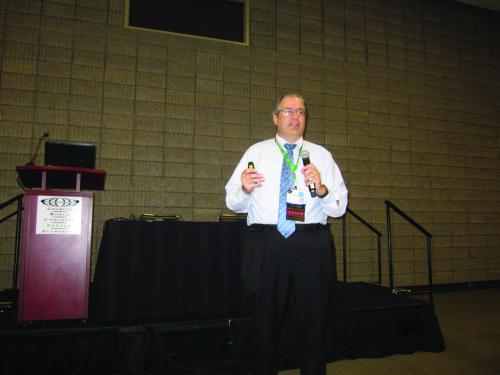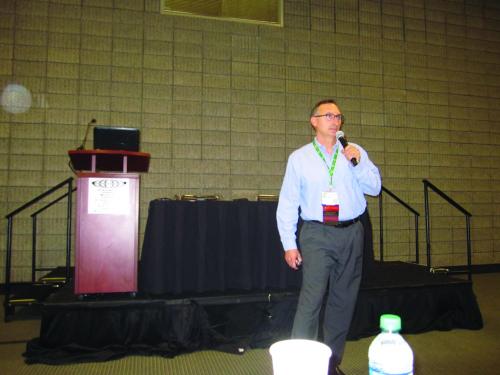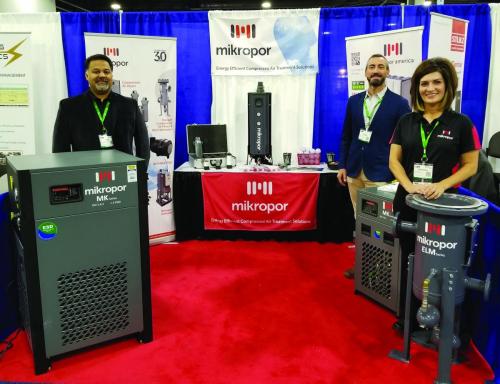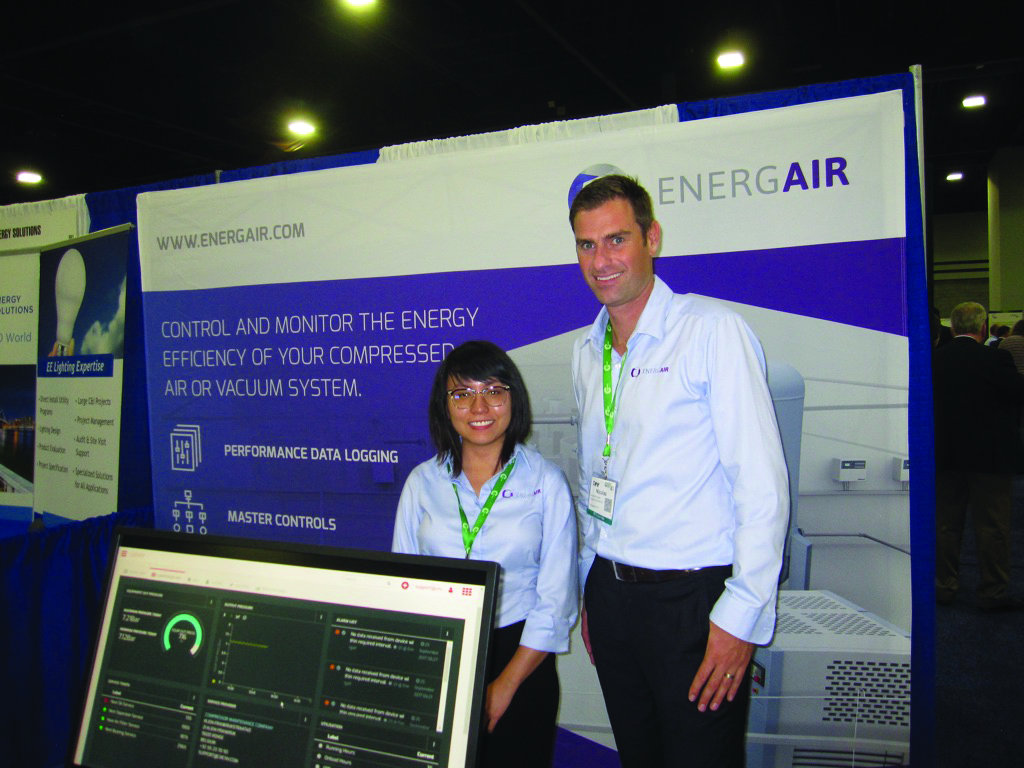The 2017 World Energy Engineering Congress (WEEC) was held September 27-29 at the Georgia World Congress Center in Atlanta, Georgia. According to the producer, the Association of Energy Engineers (AEE), the WEEC is the largest energy conference and technology expo held in the U.S. specifically for business, industrial and institutional energy users. Widely known for its recognized energy certification programs, including the Certified Energy Manager CEM® program, the AEE has led the development of the fields of energy engineering and energy management since its’ founding in 1977.
The Association of Energy Engineers (AEE) has a membership base of over 17,500 professionals in 98 countries and has 96 locally-run chapters. Both Chiller & Cooling Best Practices and Compressed Air Best Practices® Magazines are honored to have a long collaboration with the AEE and were pleased to chair two sessions, be in the literature bins and to have a booth at the 2017 WEEC!

We thank the Michelin energy management leaders, Olivier Selosse and Thomas Sullivan (our Editorial Board Member) for all their support (left to right)!
“Best Practice” Conference Session for Compressed Air and Chiller & Cooling Systems
The WEEC deploys 14 simultaneous conference tracks – impressive! I have had the great opportunity to Chair a 2-hour session for compressed air for many years – and we’ve just done our second straight year with a second session on chiller and cooling systems. Our sessions are quite well attended, averaging 70 to 90 people, which is a testament to the speakers we invite to present. . I’d like to thank our speakers for making the time and for presenting.
Compressed Air Best Practices® Magazine hosted a WEEC Conference Session on September 28th titled “Best Practices in Compressed Air.” The session presenters this year and their topics were:
- “Reducing Site Cost through Ultrasonic Air Leak Surveys and Repairs,” James Nipper, Vice President, Petro Chemical Energy
- “Why do Compressed Air Systems Need Drying?” Frank Moskowitz, Service Manager AIRScan, Atlas Copco Compressors
- “Anatomy of a Compressed Air Project,” Paul Edwards, President, Compressed Air Consultants
- “Applying Root Cause Analysis to Compressed Air,” Neil Mehltretter, Systems Engineer, Kaeser Compressors
Chiller & Cooling Best Practices® Magazine hosted a WEEC Conference Session on September 29th titled “Best Practices in Chiller & Cooling Systems.” The session presenters this year and their topics were:
- “How to tell if your Chiller Plant is Optimized?” Brett Rasmussen, P.E., Senior Energy Engineer, Nissan North America
- “District Chilled Water Optimization at an Academic Medical Center,” Kevin Kanoff, C.E.M., Campus Energy Engineer, Milton S. Hershey Medical Center
- “Water & Energy Efficient Operation of Open & Closed Loop Cooling Towers,” Matthew Shank, Industrial Process Application Manager, Evapco
- “Energy-Efficient Operations of Cooling Towers,” Mark Pfeifer, Technical Services Manager, SPX Cooling Technologies

Brett Rasmussen, P.E., Senior Energy Engineer, Nissan North America, presented; “How to tell if your Chiller Plant is Optimized?”

Kevin Kanoff, C.E.M., Campus Energy Engineer, Milton S. Hershey Medical Center, presented; “District Chilled Water Optimization at an Academic Medical Center”.

Frank Moskowitz, Service Manager AIRScan, Atlas Copco Compressors, presented; “Why do Compressed Air Systems Need Drying?”
ENERGY STAR® Industrial Sector Partnerships
The ENERGY STAR for Industry program, run by Walt Tunnessen and Elizabeth Dutrow, is an amazing program within the U.S. Environmental Protection Agency (EPA). Readers of our publications know we are always profiling ENERGY STAR Industrial Energy Management Partner of the Year award winners. For companies simply wanting to certify their own plant, they have an interesting energy management tool they call the ENERGY STAR Challenge for Industry. There are over 900 sites using it in North America. In order to participate, a site expresses its goal to achieve an energy intensity reduction of 10 percent in five years or less. A plant baseline is developed and registered with ENERGY STAR. They then have to track their progress and report when they achieve the goal.
At the WEEC this year, ENERGY STAR National Program Manager Walt Tunnessen chaired an excellent session titled, “Striking Gold! Tales from the Treasure Hunt.” Treasure Hunts are a low/no-cost two-day events held at factories to discover energy savings (treasure)! They are distinguished and defined by having very fast ROI’s. ENERGY STAR provides excellent training and assistance so plants can learn to hold Treasure Hunts. This session had Energy Managers from Intertape Polymer Corporation, Bristol Myers Squibb, Olin Brass and General Motors Company providing tales from their adventures.

Nitin G. Shanbhag, Volkan Ayhan and Christina Bailey (left to right) at the Mikropor America booth.
Compressed Air System Optimization and the Internet of Things
One obstacle to air compressor efficiency is what’s called “artificial demand.” Compressed air pressure drop, in the system, causes air compressors to work at higher pressures (and higher kW) than necessary. Pressure drop is often caused by poorly designed, or maintained, compressed air purification products.
Focusing on minimizing pressure drop, Mikropor America had several interesting innovations to their compressed air purification products, described to me by Mikropor America President, Nitin Shanbhag, “We have oversized the 1 micron pre- and 0.01 ppm post-filters integrated into our MK Series digital cycling refrigerated dryers.” Combined with a 3 in 1 heat exchanger, oversizing the filters allows Mikropor to publish an extremely low < 3 psi pressure drop for the whole package. What’s equally impressive, to cynical ‘ol me, is these dryers are performance tested (for dew point and pressure drop) under the CAGI Performance Verification testing program. I also liked the fact that units larger than 175 scfm and larger have standard high pressure and suction pressure gauges (old school service-friendly!).
Airleader and CS Instruments had booths side-by-side displaying their compressed air management and measurement technologies. General Manager and Lead Auditor Jan Hoetzel has really come a long way bringing these German technologies to the U.S. market. They are uniquely positioned to provide end users with both air compressor automation products (and knowledge how to use them) plus the instruments required to measure what’s going on. The instruments include flow, dew point, data loggers, pressure, amps, and leak detection. I was able to personally visit an Airleader client recently in Chicago (article coming soon!). The President was delighted to show me, on his desktop computer, the energy consumption of his compressed air this year by month! The Airleader software was running the air compressors, incorporating data from specific instruments and giving him a running tracker of specific power (kW per 100 scfm) as his key performance metric. Aside from liking the software, they had already realized six figure \$ energy savings and received a \$177,000 incentive check from ComEd Chicago! Great stuff.

Alan Brossault (Compressor Management), Josh Wamser (Air Support iO), Jesus Molina (Thor Industrial), Steve Briscoe (IAC Air Compression) and Jan Hoetzel made the Airleader booth their headquarters (left to right)!
VP Instruments had a booth displaying their compressed air flow measurement technology – plus they always bring the best cookies/cakes from Holland! Menno Verbeek commented, “Our recent seminars on compressed air measurement have been well attended as we continue to educate on how to properly deploy flow meters in compressed air systems.” We reviewed their new and improved VPFlowScope DP flow meter, designed for “real world” hot and saturated compressed air conditions. “We have the only insertion flow meter designed to handle moisture,” said Verbeek. “We’ve improved the internal filtration designed to keep the moisture out.” I’m personally a big believer in compressed air flow measurement – but users need to understand compressed air is a tricky fluid to measure and how to do it properly. Another note of importance is the VP Sensor Cartridge has made flow metering something maintenance can handle like filtration. One can simply change the sensor cartridge – rather than send the whole unit out for calibration.

Menno Verbeek and Chuck Mays (left to right) at the VP Instruments booth.
Case Controls, a leading air compressor automation company focused on centrifugal air compressors, was acquired over the past year by Blake & Pendleton. Blake & Pendleton is one of the larger compressed air system sales and service providers in all of North America, enjoying significant market shares in the Southeast. Congratulations go to their management leadership (Allen King and Mike Gembala) for B&P’s steady multi-decade growth - doing things the right way. By acquiring Case Controls, it now complements another subsidiary B&P subsidiary, iZ Systems, which is a leading compressor automation company whose focus has been primarily on rotary screw air compressors. The combined firms had a booth, for the first time, where their combined compressor automation products were on display.

Mike Gembala, Lou York, Ron Mazur, Dean Smith and Alton Stokes (left to right) at the Case Controls and iZ Systems booth.
CAM Technologies had a booth where they presented their CAMLink™ Online compressed air visibility and energy optimization system. The system provides system data collection, alarm monitoring and preventative maintenance indicators via email or text. It can be integrated with the CAMLink™ advanced service program as well.
President Chris Wagner explained, “CAMLink Online helps reveal patterns of energy waste that build up between audits and are unseen during walkthroughs.” Wagner continued, “The system has government-level firewalls to ensure security while providing access flexibility to connect from any desktop, laptop, tablet or smart phone.”

Ahmad Mustafa, Paul Edwards (Compressed Air Consultants), Chris Wagner, Chris Wells and Jeff Kahn (left to right) at the CAM Technologies booth.
The Hitachi Air Technologies group continues to focus on oil-free air compressors, offering both oil-less scroll compressors and oil-free rotary screw compressors. The oil-less stand-alone scroll air compressor range goes up to 16.5 kW. Their rotary screw compressors include two-stage fixed speed units with capacities up to 240 kW and two-stage VSD units with capacities up to 240 kW.
EnergAir had a booth displaying their compressed air and vacuum Metacentre™ system control products. This “intuitive visual software” helps customers visualize what is happening in their compressed air system. General Manager Nicolas De Deken emphasized the growing demand for visualization, monitoring and automatic controlling of air compressors. Some plants have been receiving the same advice for years, from their air compressor vendor, but until they see it from a computer software system – they don’t take action. Mr. De Deken provided us a good example in our recently published “Great Plains and Air Capital Equipment Monitor Great Savings” article.

Van Tran and Nicolas De Deken (left to right) at the EnergAir booth
Chiller and Cooling System Optimization
Chillers represent one of the largest energy consumers in a plant. The percentage of the total plant power they consume will vary, like compressed air, from plant to plant and by type of industry. Here are some quick and random notes I took from conference lectures of interest (at least to me!):
- a typical demand breakdown for a pharmaceutical plant is HVAC (65%), Equipment (25%) and Lighting (10%). Chilled water optimization is the project driver for HVAC (Allergan Pharmaceuticals)
- Kimberly Clark’s 100 plants have a \$700 million annual energy spend. Started energy management journey in 1995. Goal to continue improving their Energy Intensity (kW per unit manufactured) is another 30 percent by 2022. Water intensity by 20 percent. Corporate \$5 million Energy Fund to help plants.
- General Motors has 170 manufacturing locations in 30 countries. Build 10 million vehicles per year and have a \$1 billion energy spend. Current Energy and Water Intensity reduction goals (MWh or cubic meters per vehicle) are of 20 and 15 percent respectively. Have established Key Performance Indicators for chiller, air compressor and boiler efficiency. Corporate \$20 million Energy Fund to help plants.
We are thrilled to welcome Nissan North America’s Brett Rasmussen to our Editorial Board! As mentioned, Brett made a chiller presentation with these highlights:
- Nissan’s Canton (Mississippi) plant produces 1,400 cars per day in a 1 mile long facility with 4.5 million square feet
- Operate the largest chiller plant in Mississippi of 25,500 Tons using Trane chillers-each using 1.3 MW. Operate a 3,500 cfm compressed air system.
- Each cooling tower supports two chillers. Optimized towers with projects on cooling tower fans, using cooling tower water directly (bypassing chillers) in winter, optimize water temperatures going to chillers
- For chillers, the key performance metric is kW/ton. Installed chiller automation system –significantly reducing kW/ton metric while monitoring and assuring delivery of required water temperatures to process (45.9 F) and HVAC (45.6 F).
- Primary and secondary pump optimization. Successful projects to eliminate use of primary pumps and to stagger start-times of secondary pumps.
Trane was a Diamond Sponsor and Smardt chillers had their usual impressive booth at the show. These firms really “get it” and have deployed a vast array of chillers and other chiller automation technologies to optimize systems. These are still early days in getting cooling towers, chillers, and pumps to work together as one system!
The 2018 WEEC will be held at the Charlotte Convention Center, October 17-19, in Charlotte, North Carolina. For more information on the 2018 WEEC, visit www.energycongress.com.
To read similar Energy Manager articles, visit www.airbestpractices.com/energy-manager.




